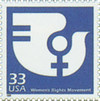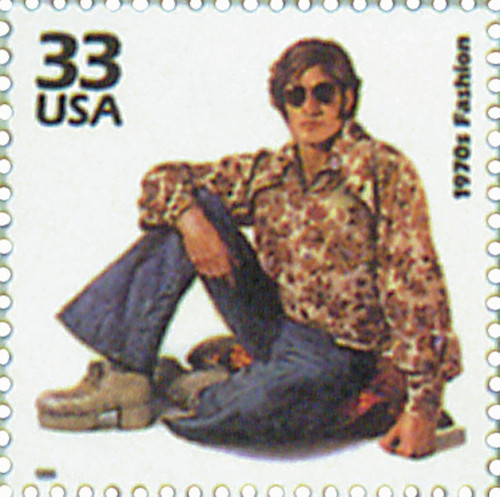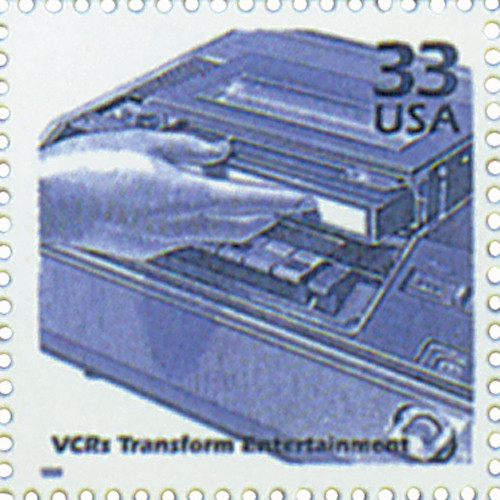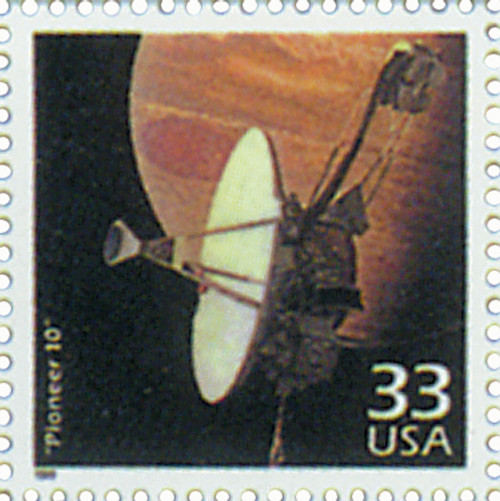
# 3189j - 1999 33c Celebrate the Century - 1970s: Women's Rights Movement
US #3189j
1999 Women’s Rights Movement – Celebrate the Century (1970s)
• Part of the eighth sheet in the Celebrate the Century stamp series issued from 1998-2000
• Commemorates the 1970s’ Women’s Rights Movement
• Includes text on the back with historical details
Stamp Category: Commemorative
Series: Celebrate the Century
Value: 33¢ First Class Mail Rate
First Day of Issue: November 18, 1999
First Day City: New York, New York
Quantity Issued: 90,000,000
Printed by: Ashton Potter (USA) Ltd.
Printing Method: Offset, Intaglio
Format: Panes of 15
Perforations: 11.5
Tagging: Block tagging
Why the stamp was issued: Honors the accomplishment of the activists who took part in the Women’s Rights Movement of the 1970s.
About the stamp design: Pictures the logo of the United Nations Fund for Women (UNIFEM). Includes the following text on the back: “The women’s rights movement mobilized to secure women’s equality, their political and economic empowerment, and respect for their human rights. The United Nations Development Fund (UNIFEM) promoted these efforts worldwide.”
First Day City: The First Day of Issue Ceremony was held at the Postage Stamp Mega-Event at the Jacob K. Javits Convention Center in New York City.
About the Celebrate the Century series: The USPS launched the Celebrate the Century series in 1998 to mark the end of the 20th century and herald the arrival of the 21st. The series includes 10 sheets of 15 stamps (150 in total), with each honoring important moments from a different decade (1900s, 10s, 20s, 30s, 40s, 50s, 60s, 70s, 80s, and 90s). At the time of completion, it was the longest and most ambitious commemorative stamp series in US history.
History the stamp represents: Although advances in women’s rights had occurred long before the 1970s, gender discrimination continued to be a persistent problem. A women’s rights movement that followed a new agenda developed during the 1970s. This renewed movement focused on changes in the law and in attitudes.
A rise in feminist militancy had emerged in the 1960s. Several political organizations which helped bring women’s issues into the mainstream developed as a result of this new interest. The National Organization for Women (NOW) was formed in 1966 by “The Feminine Mystique” author Betty Friedan. Among the members of the National Women’s Political Caucus, organized in 1971, were nationally known feminists Bella Abzug, Shirley Chisholm, and Gloria Steinem.
The women’s movement made headlines in the 1970s by burning bras and staging protests at beauty contests, which feminists believed demeaned women. But the movement’s main focus was on the ratification of the Equal Rights Amendment. The measure, which banned gender discrimination, was approved by the House of Representatives in 1971 and by the Senate in 1972. Ratification of the amendment fell three states short of the necessary 38 in 1982.
US #3189j
1999 Women’s Rights Movement – Celebrate the Century (1970s)
• Part of the eighth sheet in the Celebrate the Century stamp series issued from 1998-2000
• Commemorates the 1970s’ Women’s Rights Movement
• Includes text on the back with historical details
Stamp Category: Commemorative
Series: Celebrate the Century
Value: 33¢ First Class Mail Rate
First Day of Issue: November 18, 1999
First Day City: New York, New York
Quantity Issued: 90,000,000
Printed by: Ashton Potter (USA) Ltd.
Printing Method: Offset, Intaglio
Format: Panes of 15
Perforations: 11.5
Tagging: Block tagging
Why the stamp was issued: Honors the accomplishment of the activists who took part in the Women’s Rights Movement of the 1970s.
About the stamp design: Pictures the logo of the United Nations Fund for Women (UNIFEM). Includes the following text on the back: “The women’s rights movement mobilized to secure women’s equality, their political and economic empowerment, and respect for their human rights. The United Nations Development Fund (UNIFEM) promoted these efforts worldwide.”
First Day City: The First Day of Issue Ceremony was held at the Postage Stamp Mega-Event at the Jacob K. Javits Convention Center in New York City.
About the Celebrate the Century series: The USPS launched the Celebrate the Century series in 1998 to mark the end of the 20th century and herald the arrival of the 21st. The series includes 10 sheets of 15 stamps (150 in total), with each honoring important moments from a different decade (1900s, 10s, 20s, 30s, 40s, 50s, 60s, 70s, 80s, and 90s). At the time of completion, it was the longest and most ambitious commemorative stamp series in US history.
History the stamp represents: Although advances in women’s rights had occurred long before the 1970s, gender discrimination continued to be a persistent problem. A women’s rights movement that followed a new agenda developed during the 1970s. This renewed movement focused on changes in the law and in attitudes.
A rise in feminist militancy had emerged in the 1960s. Several political organizations which helped bring women’s issues into the mainstream developed as a result of this new interest. The National Organization for Women (NOW) was formed in 1966 by “The Feminine Mystique” author Betty Friedan. Among the members of the National Women’s Political Caucus, organized in 1971, were nationally known feminists Bella Abzug, Shirley Chisholm, and Gloria Steinem.
The women’s movement made headlines in the 1970s by burning bras and staging protests at beauty contests, which feminists believed demeaned women. But the movement’s main focus was on the ratification of the Equal Rights Amendment. The measure, which banned gender discrimination, was approved by the House of Representatives in 1971 and by the Senate in 1972. Ratification of the amendment fell three states short of the necessary 38 in 1982.














